Family : Istiophoridae

Text © Giuseppe Mazza

English translation by Mario Beltramini
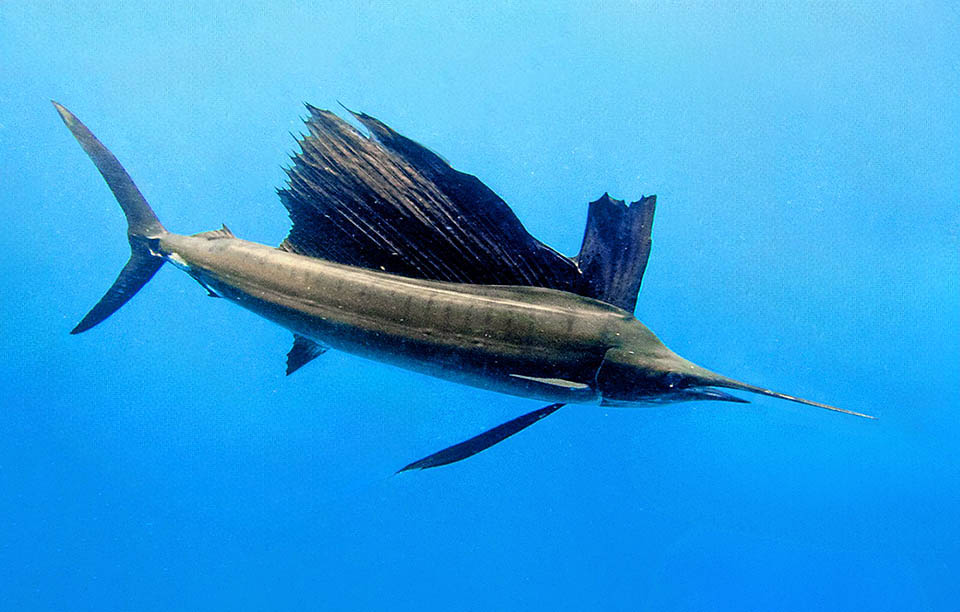
Thanks to its huge dorsal fin, that folding reduces the water resistance, Istiophorus platypterus is able to reach 110 km/h © Rémi GP
Which is the fastest fish?
According to some experts it should be the Indo-Pacific sailfish Istiophorus platypterus (Shaw, 1792) with speed peaks over 110 km/h, and it seems that during a sport fishing has unrolled 91,4 m of fishing line in 3 seconds.
The aerodynamic body and the dorsal fin shaped like a sail, that may fold in order to reduce the water resistance, are its strongpoints, and even more, emerging it, rich as it is in blood vessels, can rapidly warm up or cool the body before or after the efforts.
In these extraordinary performances it is closely followed by the Black marlin, Istiompax indica (Cuvier, 1832), by the Swordfish, Xiphias gladius Linnaeus, 1758, and by the Shortfin mako shark, Isurus oxyrinchus Rafinesque, 1810.
The genus created by Lacépède in 1801 from the Greek “istios”, sail, and “phorus”, bearer in Latin, is a clear reference to its amazing dorsal fin. The specific term platypterus, flat and wide,also refers to the same.
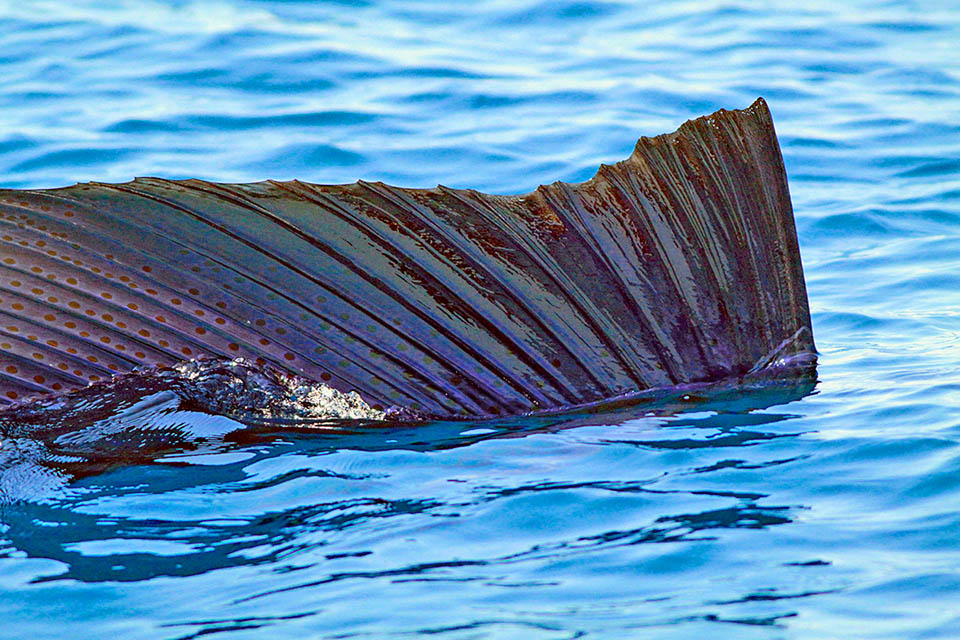
Moreover, emerging it, rich as it is in blood vessels, Istiophorus platypterus can rapidly heat or cold the body before or after the efforts © harrier
Then a learned taxonomic dispute arose about this species belonging to the class of the Actinopterygii, the ray-finned fish, to the order of the Carangiformes and to the family of the Istiophoridae.
The IUCN, the International Union for Conservation of Nature, in fact considers it as cosmopolitan, whilst Fishbase reports two species: Istiophorus platypterus for the Indo-Pacific and Istiophorus albicans (Latreille, 1804) for the Atlantic and the Mediterranean where it is not a Lessepsian species as it was already present before the Suez Canal.
The morphological difference between the two species is however minimal because the Atlantic specimens are just slightly smaller.
Zoogeography
In any case, Istiophorus platypterus is a migratory fish widely distributed where the sea temperature stands between 18,2 and 27,7 °C.
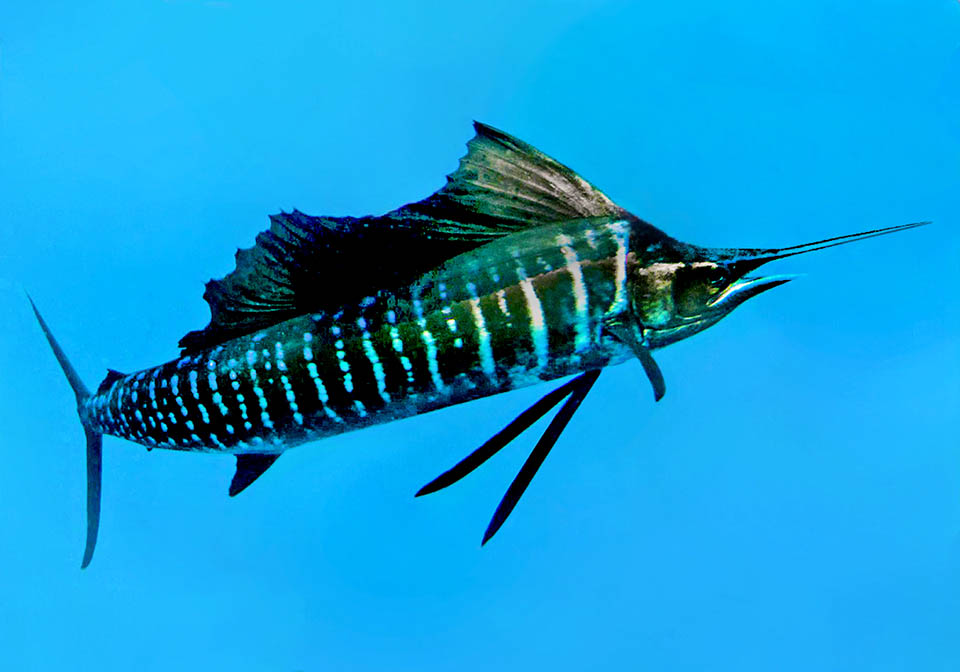
About 270 cm long, with a peak of 360 cm and weighing over 100 kg, has a dark livery, but depending on the mood, it may display 20 vertical bars done by light blue dots © Rafael de la Parra
We find it not only in the Indo-Pacific but also in the west Atlantic, from the Caribbean Sea and the Gulf of Mexico up to the coasts of Florida, which goes up in the summer northwards with the increase of temperature.
In the eastern Atlantic it reaches, following the Gulf Stream and from the Canaries goes down towards western Africa up to the Ivory Coast and then, in autumn, goes back to the Caribbean with the return branch of the same current.
In the Indo-Pacific, starting from the Red Sea, is present up to South Africa and then in India, Indonesia, Japan, Australia, New Zealand, Fiji, Hawaii, Easter Island, Galapagos, Pacific Central America, Ecuador, Peru and Chile.
Ecology-Habitat
Istiophorus platypterus is a pelagic fish found in the open sea and along the coasts, between the surface and the depth of 10 m, but can go down up to 100 m and off Brazil has been reported at 500 m.
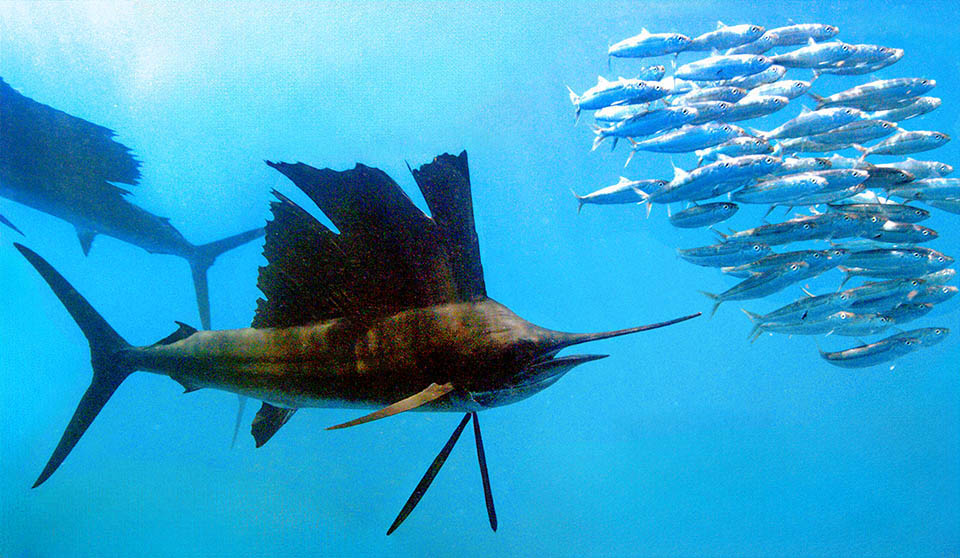
Species unluckily considered vulnerable, usually swims in the first 10 m of water, mainly eating fish belonging to the Scombridae family © rudi-diesel
Morpho-physiology
The Indo-Pacific sailfish can reach 360 cm and weigh more than 100 kg, but the normal length is about 270 cm.
The body, covered by small triangular blunt scales that reduce the friction with water, is relatively compressed with the pointed jaws equipped with small villiform teeth that are also present on the palate. The upper one is a long round-section sword, used for stunning the prey.
The even 150 cm long dorsal fin is formed by two parts of soft rays: the first, very big, counts 42-49 of them and the second 6-7.
The pectoral fins are long and sharp with 18-20 rays; the pelvic, very long and foldable in a groove, almost reach the anus; there are two anal fins: the first with 12-17 rays and the second with 6-7 rays, and we note two keels on the sides of the tail; the big caudal fin is strongly forked and rigid as befits fast swimmers.
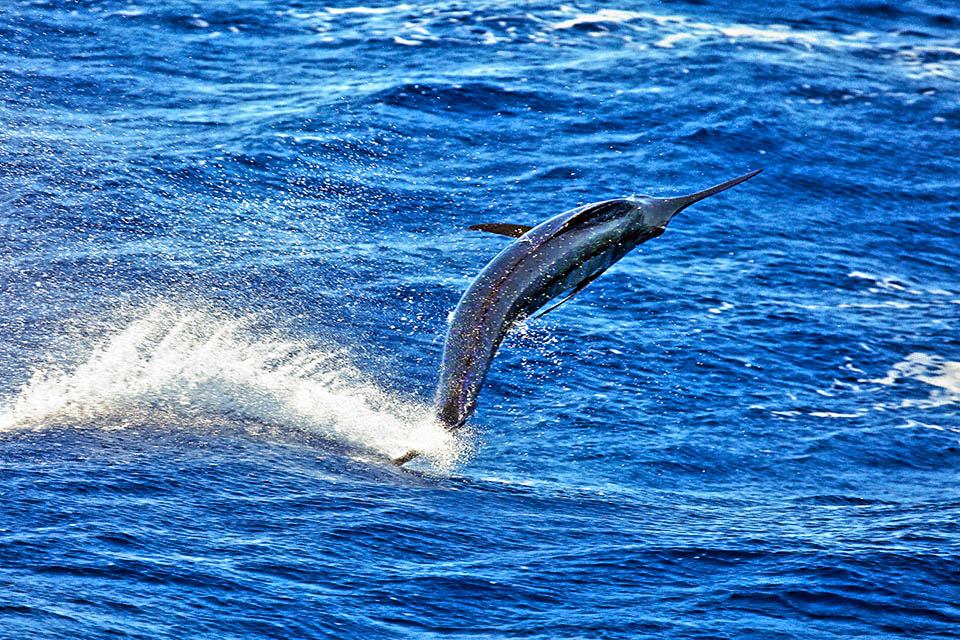
It surrounds them, moving in small groups, and compacts them up with leaps and sword blows to stun and then eat them calmly one by one © Laura Keene
The livery is dark blue on the back, light blue with brown spots on the sides and silver white one belly. It changes depending on the mood of the fish who may appear with 20 vertical bars on the sides formed by light blue spots. The membrane of the first dorsal fin is dark blue or blackish, with small scattered small dots.
Ethology-Reproductive Biology
Even if it does not leave out bottom animals such as crabs, gastropods, octopuses and squids, Istiophorus platypterus mainly eats pelagic fish belonging to the family of the Scombridae. It surrounds them by moving in small groups often formed by individuals of the same age, compacting the fish of the schools towards the surface with leaps and sword strokes to stun them and then to devour them one by one.
The females are bigger and grow faster than the males reaching sexual maturity when they are 2,5 years old. The reproduction appears to occur all over the year with a peak during the summer seasons. The eggs, containing one granule, oily for floating, are entrusted to the currents and the life expectancy of the unborn is of about 13 years.
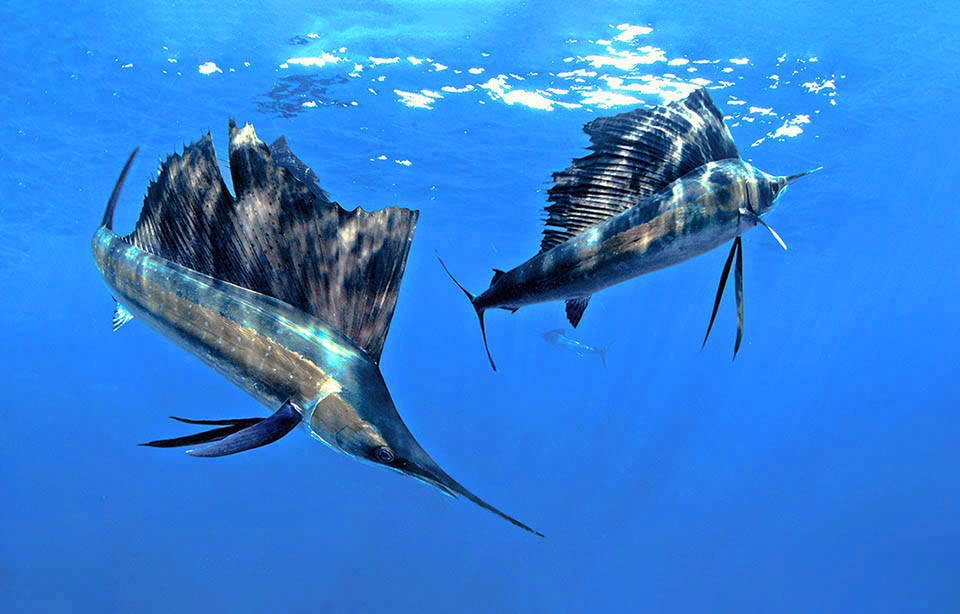
Reproduction seems to occur all over the year with a peak in summer seasons. Eggs are entrusted to the currents and newborns’ life expectancy is about 13 years © edgarku
The resilience of the species is low with a minimum time for doubling the populations of 4,5-14 years, and the fishing vulnerability, moderate, marks 41 on a scale of 100. The sport fishermen, looking for memorable photos, are its main enemies,, but it also runs into longlines, purse seines, gillnets and trawling nets. Its flesh is tasty. and its liver is rich in vitamin A.
Unfortunately, since 2021 Istiophorus platypterus appears as “VU, Vulnerabile” in the IUCN Red List of the endangered species.
Synonyms
Xiphias platypterus Shaw, 1792; Scomber gladius Bloch, 1793; Histiophorus gladius (Bloch, 1793); Xiphias velifer Bloch & Schneider, 1801; Istiophorus gladifer Lacepède, 1801; Histiophorus immaculatus Rüppell, 1830; Istiophorus immaculatus (Rüppell, 1830); Histiophorus indicus Cuvier, 1832; Histiophorus orientalis Temminck & Schlegel, 1844; Istiophorus orientalis (Temminck & Schlegel, 1844); Istiophorus triactis Klunzinger, 1871; Istiophorus dubius Bleeker, 1872; Istiophorus japonicus Jordan & Thompson, 1914; Istiophorus eriquius Jordan & Ball, 1926; Istiophorus gladius greyi Jordan & Evermann, 1926; Istiophorus brookei Fowler, 1933; Istiophorus amarui Curtiss, 1944.
→ For general information about FISH please click here.
→ For general information about BONY FISH please click here
→ For general information about CARTILAGINOUS FISH please click here.
→ To appreciate the BIODIVERSITY of BONY FISH please click here.
→ To appreciate the BIODIVERSITY of CARTILAGINOUS FISH please click here.
